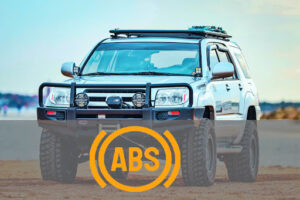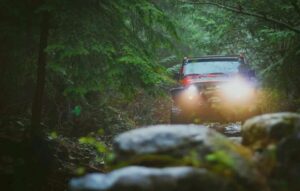Off roading is a very popular outdoor fun activity for many decades. Vehicle makers also try to add more capabilities to vehicles to beat extreme terrains.
That’s why 4wheel drive (4WD or 4×4) systems were also invented and developed.
But really do we need 4WD to go off-roading? Can we go off-roading with a 2WD vehicle?
Simple answer for the above is yes, you can do off-roading with a 2 wheel drive vehicle. It’s not crucial to have a 4WD for off-roading. But even 4WD vehicles have their own limitations, with a 2WD vehicle you can’t expect high off road performances like a 4WD vehicle.
But with better driving skills and tricks you could be able to beat some tough terrains with a 2WD.
In this guide we’ll look for some tips as well, to beat different off road terrains like mud, sand with your 2WD.
Contents
What a 4WD system does?
When a vehicle is put into 4Low or 4HI, the transfer case connects with the front drive shaft.
That means engine power divided among front and rear wheels.
Normal vehicle driven by just front wheels or rear wheels.
But these 4WD vehicles can give power to all the four wheels and give more traction to move the vehicle forward.
That means they are driven by all four wheels.
You can read more about how these 4WD system works by clicking here.
4WD vs 2WD for off roading
Traction & stability –
As I mentioned earlier 4WD vehicles give more traction and stability than a 2WD vehicle because it’s driven by all the four wheels.
With that traction 4WD vehicles can easily propel forward in mud bogs, slippery hills and rocks.
When it comes to a 2WD vehicle it can move forward until it loses the traction same as the 4WD vehicle.
But because the traction that can be given by a 2WD is low, the distance it can move can be reduced.
But with using some driving techniques and common sense a skillful driver may also be able to beat tough terrains with a 2WD vehicle.
Tires –
Normally off road dedicated vehicles have special large tires like mud terrain tires.
They increase the traction on dirt for few times, than a street tire.
But 2WD vehicles generally have street tires for smooth noise free driving. They easily slip and spin unnecessarily on dirt.
If you are planning to drive off the payment frequently, you can change your street tires with mud terrain tire set or all terrain tire set. It will drastically increase the traction on the off road terrains.
Lockers –
Differential lockers can lock the two wheels of an axle and spin them at the same speed.
This is very important for off-roading and most of the 4WD vehicles and some 2WD vehicles are equipped with diff locks.
I wrote a detailed guide about how diff locks and hub locks works. You can learn more about lockers by clicking here.
Suspensions –
Street driven 2WD rigs have soft suspensions for comfortable ride for passengers. But they are not appropriate for off roading on uneven terrains.
Those suspensions can easily damage or one wheel can lift off the ground and lose traction when trying to crawl over uneven surfaces.
That happens due to reduction of vertical wheel travel by soft shorter springs.
4WD vehicles have tough and long springs that allow for higher wheel travel. They stand against abuses caused by tough off road terrains.
Ground clearance –
Due to shorter suspension springs and lowered center of gravity , normally 2WD vehicles have low ground clearance.
This type of lowered center of gravity design is convenient for highway usage. Not for off roading purposes.
That low ground clearance reduces the approach and departure angles of the vehicle.
Undercarriage parts like oil pans can be easily damaged with hitting roots or rocks on the terrain.
4WD vehicles have higher ground clearance and they can easily crawl most of the obstacles on the trails easily without hitting undercarriage.
If you can improve your 2WD vehicles suspension system with a lift kit or off road ready suspensions you can overcome above problems.
But lifting can cause different problems.
So the easiest thing is to drive carefully and stay within the vehicles limits. If you are not doing serious off roading frequently with your 2WD rig, it’s better stay away from lift kits.
Gear ranges –
4WD vehicles have 4LOW (4L) and 4HI(4H)ranges in their transfer cases.
This 4L gives high torque and slow speed to the wheels. That’s very useful for maneuvering over difficult obstacles and tough terrains on off roads.
This is the factor we can’t achieve in any way by a 2WD vehicle. As well as this is, one of the most important factors to beat extreme off-road terrains.
Without this 4L range 2WD vehicles’ off roading ability is hugely reduced.
That’s why it’s advised not to attend extreme off roadings like rock crawling with a 2WD vehicle.
To rock crawl safely you should have 4L range.
Extra equipments –
Extra off roading equipment gives support and protection for off roading vehicles unlike street 2WD vehicles.
Winch – Helps to winch stuck vehicles or support in off cambers to protect from vehicle roll overs.
Off road Bumpers – Increases approach and departure angles of the vehicle.
Off road fenders – Allow for fitting larger wheels. Give space for high wheel travel distance without hitting on wheel wells.
Rock sliders – Protects the sides of the off road vehicles from dents and damages. Rock sliders helps to maneuvering sharp trail bends easily with the help of rocks or large roots of trees on trails.
Skid plates – Protects undercarriage parts like fuel tanks, oil pans from damages.
Tips for driving 2WD on different off road terrains
So far I think you got an idea about what are the off roading capabilities of a 4WD off road vehicle vs your 2WD vehicle.
With that knowledge you will be able to decide what are the limits you have and what are the things you can do to extend those boundaries.
Now let’s look at some tips and tricks to beat different off road terrains with your 2WD vehicle.
Can you mud in a 2WD vehicle?
Yes of course you can go mudding with a 2WD vehicle. But the rule of thumb is stay in your limits.
Don’t put 2WD rigs into deep boggy mud. It will stuck there in no time!!
How to drive in mud with 2WD vehicle?
First know the depth of the mud you are going to put the rig.
This can check the depth by poking to the mud with a wood stick if you are in an unknown trail.
There can be hidden logs or rocks under the mud that can damage your vehicle. Be aware about that also.
If the depth is higher than half of the wheel height of your stock 2WD vehicle and mud is sticky there’s a high probability of getting stuck in the middle of the mud.
Main reason for that is that your chassi can sit on the sticky mud and give extra frictional force in the opposite direction.
It’s better if you can use a set of mud terrain tires, if you are going to mudding. Street tires easily lose traction in slippery mud.
If you have lockers then turn the lockers on before entering to mud.
Don’t try to change gears in the middle of the mud if you are driving a manual vehicle.
Manual shifting middle of the mud loses the momentum and traction.
Select one gear and drive throughout the mud puddle in that gear. (2nd or 3rd gear may be most suitable for this.
But it will depend on your vehicle type.)
Take the advantage of momentum and move forward with some speed. But don’t drive too fast.
It can lead to accidents if tires slip on mud side to side.
If wheels tend to spin in place, steer back and forth to allow wheels to find traction. (This will work best for front wheel drive vehicles.)
If your vehicle is stuck in mud don’t smash the gas pedal and spin the wheels unnecessarily.
It will not help and that can worsen the condition. Because wheels will cut down the mud and vehicles will bog down more.
In this case you can try moving the vehicle backward on the same ruts created by the wheels and move forward again with some momentum.
Doing this few times will help to move your vehicle forward through the mud.
Then you can try using some traction aids like maxtrax/ gravel/ carpets.
If a vehicle can’t move forward or backward then you have to remove mud around the wheels and under the chassi if the chassis sits on the mud.
If you are driving a rear wheel drive vehicle, try adding some weight to the back of the vehicle.
It will increase the traction of the rear wheels.
If any of the above things do not work for you, then you have to winch out your vehicle or get support from another vehicle to take your vehicle out.
Can 2WD vehicle do snow off roading?
Yes, you can drive your 2WD vehicle on snow as well, while staying in your limits.
I had written separate guides for off roading on snow and 2WD off roading in sand.
You can read them to know how you can beat those terrains with your 2WD vehicle without stucking.
Final word
Now I told you what are the off roading capabilities of your 2WD vehicle, how to improve your vehicles off roading performances.
Finally taken you through a step by step guide to drive your 2WD vehicle in muddy terrain and more references to beat snow and sand terrains.
If you think this guide may be helpful for someone you can share this with them. You just have to hit a share button below
Have fun and safe off roading!!



